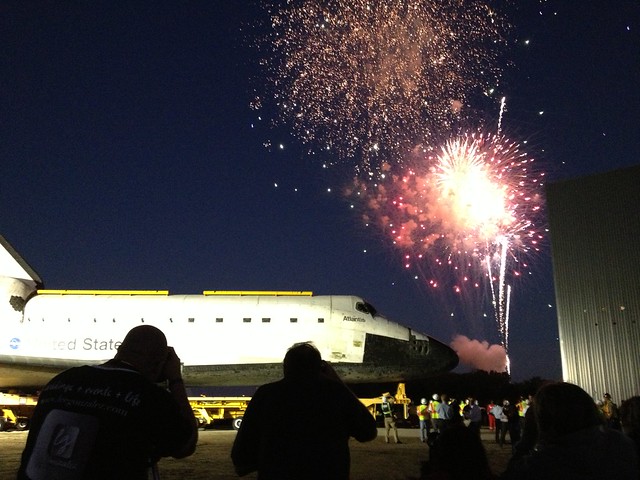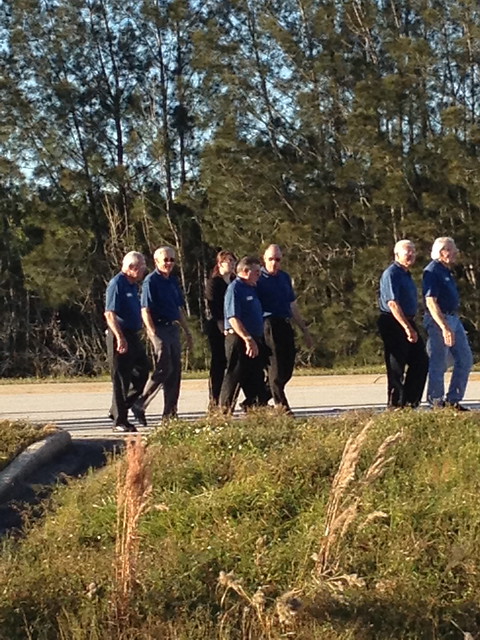I finally made my first trip to the Kennedy Spaceflight Center this past weekend. The draw for me was the Astronaut Autograph and Memorabilia Show, which had a handful of Mercury, Gemini, and Apollo astronauts and engineers signing autographs and talking to fans. It was, in short, a space history nerd’s dream. It turned out that the space shuttle Atlantis was also rolling over that weekend – rolling, that is, from the Vehicle Assembly Building to the site of its as-of-yet unbuilt display. Some last minute media credentials gave me access not only to the whole rollover event but to the people that came out to see it. Who, you might wonder, would come out to watch a space shuttle slowly roll a couple hundred feet? The type of serious shuttle dorks that move to Florida just to be close to the launches, that’s who.Atlantis, officially designated OV-104, was the fourth shuttle to join NASA’s fleet. In its more than quarter-century career that began in October of 1985, Atlantis flew 32 missions, carried 155 individual astronauts a total of 120,650,907 miles over 4,648 orbits. Its total flight time was less than one year: 293 days, 18 hours, 29 minutes, and 37 seconds. Atlantis also has a clone; the shuttle Endeavour was built from duplicate parts built for Atlantis.As for interesting missions, it was the first shuttle to dock with the MIR space station, which it did six times before focusing on the International Space Station, with which it docked 11 times. Atlantis was the last shuttle to visit the Hubble Space Telescope, and when it sent astronauts to repair the orbiting telescope in 2009 Atlantis became Leonardo DiCaprio’s costar in the IMAX movie “Hubble 3D.”All in all, it’s not a bad résumé. But I wasn’t all that excited to watch the rollover. Full disclosure: I’m not a shuttle hugger. The shuttle was never, in my opinion, the best post-Apollo path for NASA to take. But that’s a separate story.
I was more excited to see what kind of people would come out to watch Atlantis’ rollover.I joined the media around noon on Friday, the rollover day – my last minute media credentials were behind security all day so I couldn’t drive out to pick them up. Midday, Atlantis was scheduled to roll into Exploration Park, a barren site that will eventual house a new part of the KSC visitors’ center, and stay put for three hours of speeches and photo ops.I sort of figured the astronauts who flew on Atlantis would be sad to see it reach its final resting place, and I knew the hardcore spaceflight fans and journalists would be out in full force to witness its last move. What I didn’t expect was the number of locals who would turn out to see it. There were six moonwalking astronauts and a handful of others on site that day, but most of the people at the KSC Visitors’ Center were there to watch a space shuttle be towed down a road at 3 miles per hour.—On my way over to Exploration Park on Friday, I met a young man who had moved to Florida three years before just to watch the last launch of every orbiter. He told me he decided to move after figuring it was actually cheaper than flying out and staying in hotels every time a launch was scheduled. Now that’s devotion. When I got there, the barren field was packed. The road along which the shuttle was set to drive was lined, three deep, with onlookers. People on a lawn had obviously staked out their spots just to get the money shot of the shuttle coming down the road nose first. There were a lot of people who looked like they were going camping, with water bottles tied to their pants and backpacks full of supplies. Shuttle huggers wearing Atlantis shirts were trying to explain to their small children why watching a spaceship drive down a road was significant.The shuttle arrived with a police escort and a trailing of people who worked on the program wearing neon vests and hardhats. People were clambering to get good views and get as close to the orbiter as possible. To be fair, it’s pretty impressive to stand in a field and have a shuttle’s wing pass right over your head, but I wasn’t ready to dissolve into tears like some people I saw. By the time it parked I left. Mercury astronaut Scott Carpenter wasn’t getting any younger and I really wanted to meet him.I caught up with Atlantis a few hours later as it prepared to drive down the main road into its resting place at the Visitors’ Center.
That last leg of the drive was like a two-hour long photo op. The stream next to the road was so still it was like a mirror reflecting the shuttle’s underside as it drove. The 30 or so astronauts who were there signing autographs walked down the road in front of Atlantis. The procession stopped three times in front of the “shuttle crossing” signs for pictures; twice for the masses and once right in front of the little media-only nook.That’s where I was, and it was impossible not to pick up on the personal stories. There were KSC employees down in that nook, people who moved from all over the country, and in some cases from across the world, just to work in a cafeteria near where the shuttles were. There were reporters who had tracked Atlantis’ whole career. Photographers from small local newspapers as far as Iowa. While the Star Wars soundtrack was played on loop over loudspeakers, the refrain in the media nook was “a sad day, this is such a sad, sad day.” People were sharing their favourite Atlantis stories, some with tears in their eyes. And they were of all ages, from young people who made a pilgrimage to Florida like it’s the space version of the promised land, to people who watched Apollo missions from their backyards. Then came the fireworks. Media were pushed back into the best spot to catch Atlantis, at this point bathed in floodlights, set against a fireworks filled dark sky. It went on for ten minutes, a really nice fireworks concentrated nicely for great pictures.
Then came the fireworks. Media were pushed back into the best spot to catch Atlantis, at this point bathed in floodlights, set against a fireworks filled dark sky. It went on for ten minutes, a really nice fireworks concentrated nicely for great pictures. Almost as abruptly as the show started it ended and the media were unceremoniously herded out. Apparently, moving the shuttle into its final resting place was both too unglamorous and too finicky for the media to see. I snapped a final sketchy shot from my car as I drove out and then hit the road, leaving the last of the hardcore shuttle huggers with their baby.
Almost as abruptly as the show started it ended and the media were unceremoniously herded out. Apparently, moving the shuttle into its final resting place was both too unglamorous and too finicky for the media to see. I snapped a final sketchy shot from my car as I drove out and then hit the road, leaving the last of the hardcore shuttle huggers with their baby.
Advertisement
Image via NASA

Shuttle huggers in freakout mode.
Advertisement
There were people who moved from all over the country just to work in a cafeteria near where the shuttles were.
Advertisement

Astronauts strolling with Atlantis.
Advertisement
The only thing more interesting than hearing the emotional attachment people had with this orbiter was watching Fred Haise, the lunar module pilot on the ill-fated Apollo 13, taking pictures with his phone of the people taking pictures of Atlantis.After the drive, things got, well, sort of odd. Atlantis rolled on to the mud outside its new hangar, which was off limits to everyone without a media badge. Four important people, like NASA Deputy Administrator Lori Garver, pulled up in Toyota trucks. They parked at an appealing angle in front of Atlantis. The pictures might be the coolest looking Toyota ad of all time, maybe second to the Toyota truck that pulled the orbiter Endeavour in California. Nevertheless, it was an awkward pause in the proceedings for a product placement.

